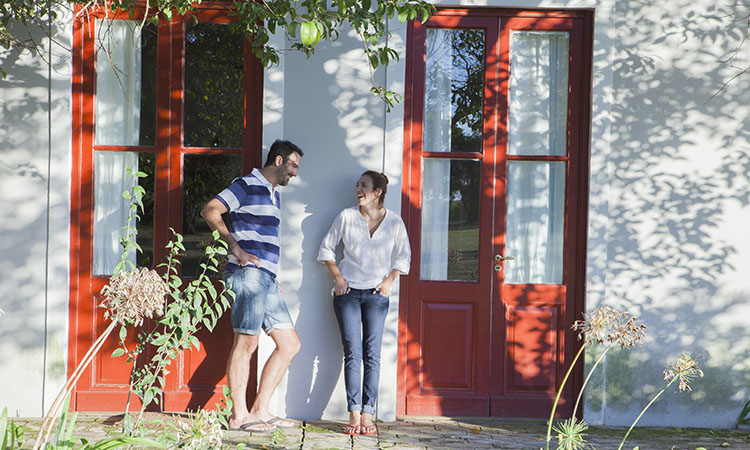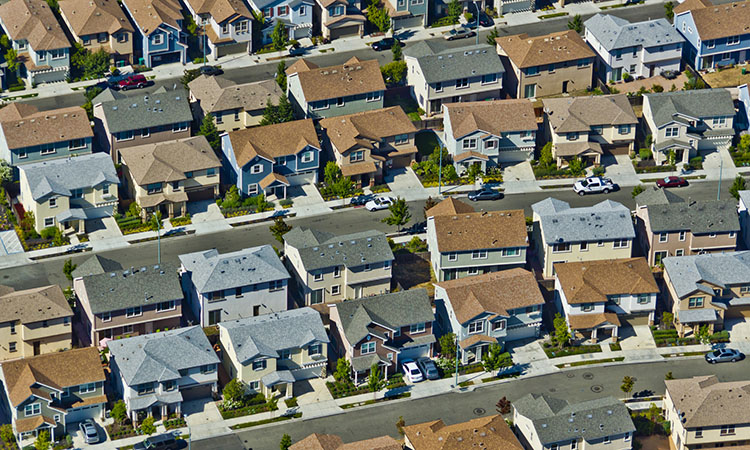
Did you know there’s a middle ground between cramped apartment-style living and midcentury suburban neighborhood sprawl. It’s called the Missing Middle, and it’s been getting some attention lately—especially here in the Asheville MSA.
Today, let’s look at what the Missing Middle is, what benefits it offers, and what it would take to have more of it here in Western North Carolina.
What is the Missing Middle?
According to Statista, as of 2021, 63.6% of America’s 128.5 million housing units were detached homes, with apartment buildings of 10+ units comprising another 13.8%. Once common in pre-WWII communities, less than one fifth of homes (17.3%) are now anything in between, including duplexes, fourplexes, bungalow courts, and townhomes.
This dearth of in-between options for home buyers was coined the “Missing Middle” by architect and urban planner Daniel Parolek of Opticos Design, Inc. Parolek recognized the growing need for a middle option between suburban sprawl and crowded apartment complexes.
And thanks to changes in Americans’ lifestyles, additional living arrangements are more important than ever.

How are Americans Living Right Now?
Since the end of World War II, the American Dream has been represented by a single-family home on a neat, level yard with lush grass surrounded by a white picket fence. According to the National Association of REALTORSⓇ (NAR) “Profile of Home Buyers and Sellers 2023”, that dream still holds true for many homeowners. Last year, the “typical” home purchased was a detached single-family home of 1,860 square feet with three bedrooms and two bathrooms.
But as lifestyles change around America, home buyers are becoming increasingly “atypical.”
As men and women are waiting longer to get married, they are increasingly finding themselves committing to a dream home before a dream partner. In 2020, 27.6% of all U.S. occupied households were one-person households, according to the U.S. Census Bureau. And the majority of those were occupied by singles under 64. Even if many of those households represent renters, that means a significant percentage of homes sold are being bought for single owners.
In addition, the number of multigenerational homes is on the rise. Numbering around 14 million in 1970, today 59.7 million people—more than four times—live in multigenerational households.
And for every single young home buyer and “modern family,” there are also older folks planning to age in place, opting to stay in a home of their own as long as possible. For these buyers, a three-bedroom suburban home may no longer be an ideal purchase. More likely, they want something smaller, easier to maintain, walkable to transit and amenities, or closer to work, social activities, and friends. In those cases, housing options have become increasingly more expensive and more difficult to come by.
Why is the Middle Missing in the First Place?
Since the 1940s, it has become increasingly more difficult to build Missing Middle housing types. Experts point to the prevalence of low-density residential zoning as a key issue. This zoning practice gives developers fewer opportunities to build bigger. This, in turn, exacerbates another problem: the high cost of land.
As a result, it has also become more difficult for developers to finance mid-scale projects. So, when factoring the cost of land, labor, and materials, developers scale up whenever they can, and they scale up as much as possible. This can be seen as an increase in size (as with large apartment complexes) or an increase in “upscale” amenities that tend to price out many first-time home buyers or retirees. And so, as new construction has moved farther to the extremes, a Missing Middle has emerged.

Why Does the Missing Middle Matter?
Missing Middle offers greater choice
Missing Middle housing offers a greater choice in housing types for every type of home buyer, giving them greater opportunity to live the lifestyles they desire. Young professionals have been shown to drive less, and they prefer living closer to city centers and public transit. Those aging in place also value amenities within walking distance, as well as proximity to transit. Many neighborhoods of detached homes cannot currently meet these needs. Because they are often in more walkable locations, Missing Middle homes attract both young adults and seniors.
Missing Middle adds affordability
Missing Middle housing also adds to the range and affordability of homes on the market. Because they are smaller homes and share communal parking, courtyards, and/or parking, they are easier to maintain, a benefit both to young people on the go and retirees ready to downsize responsibilities. Mid-size multi-family homes are also of greater benefit to developers and investors because they offer multiple sources of income from the same property.
Missing Middle connects neighbors
In addition, many Missing Middle options work well for neighbors. Duplexes and fourplexes, for example, can easily blend into existing single-family neighborhoods, unlike mid-rise apartment buildings. In fact, these types of homes typically have a residential unit density in the range of 16–30 units per acre—but they do not feel as dense because of their small scale. Movements like local tiny house communities are already looking for ways to build density into established neighborhoods and offer affordable options for buyers with “tiny” lifestyles. Missing Middle housing proposes to address the issue on a slightly larger, “middle” scale.
Missing Middle makes cities healthy
Missing Middle housing could possibly also keep cities healthier for longer. Proponents of Missing Middle housing say that it helps keep rents from rising too quickly. This, in turn, helps young professionals save, and actually increases their ability to grow their real estate wealth over time.
Where it exists, mid-range multi-family housing development has been found to be very adaptable to changing economic environments, amenable to conversions of all types….
However, where it does not exist it causes problems for cities trying to adapt to a new era in urban living. Unlike the recent past, where young adults moved swiftly from their parent’s home to college, and then to their own single-family home, there are growing numbers of urban dwellers who are choosing renting over owning, multi-family over single-family development, and access over space. Cities have responded to this by accelerating the building of large-scale developments within the context of modern zoning. Much of what one sees happening in the trendy hot spots around the nation are a testament to this.
By investing in Missing Middle housing, small and large cities can increase density, meet the demands of changing demographics, and avoid the ever increasing need for affordable housing that paradoxically drives up rent.
What Information are You Still Missing?
Does this answer all your questions about Missing Middle housing? Do you think you’d be comfortable in a Missing Middle type of home, or do you see yourself living behind a picket fence? Let us know your thoughts in the comments below.
NAI Beverly-Hanks continually strives to be the best in the business and provide you with the expertise you need. Contact us today to speak with an NAI Beverly-Hanks agent about multi-family investment opportunities in the Asheville MSA.